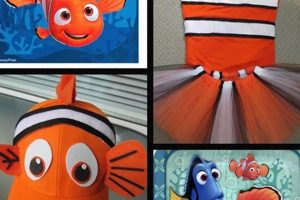The concept involves the creation of a Viking-inspired attire for women through self-made efforts. Instead of purchasing a pre-made ensemble, individuals undertake the task of designing and assembling the various components such as garments, accessories, and weaponry, using available materials and personal crafting skills. An example would be crafting a tunic from linen fabric, embellishing it with faux fur trim, and pairing it with handmade leather bracers.
Such projects provide an opportunity for creative expression and personalized interpretations of historical fashion. Building such an outfit allows for cost savings compared to purchasing commercially produced costumes and enables the wearer to tailor the design to their specific body type and aesthetic preferences. Furthermore, it fosters a connection to the historical period through hands-on engagement with the materials and construction techniques involved.
The following discussion will elaborate on material selection, garment construction techniques, and accessory creation strategies to facilitate the successful realization of a handcrafted Viking-themed ensemble. These details will assist with crafting a historically plausible and visually appealing piece.
Creating a Viking-Inspired Garb
Achieving a convincing aesthetic requires attention to historical detail and quality of construction. The subsequent guidance highlights several critical aspects to consider when embarking on such a project.
Tip 1: Material Selection: Opt for natural fibers such as linen, wool, and leather to emulate authentic Viking attire. Avoid synthetic fabrics, as they detract from the overall historical accuracy of the result.
Tip 2: Garment Construction: Employ hand-sewing techniques or utilize a sewing machine with a focus on strong, durable seams. Examine extant historical examples or reliable reconstructions to understand garment patterns and construction methods.
Tip 3: Layering: Viking attire typically involved multiple layers. Start with an underdress, followed by a tunic or apron dress, and potentially an overcoat or shawl. This layering not only provides warmth but also contributes to the visual complexity of the attire.
Tip 4: Accessories: Incorporate historically plausible accessories such as brooches, belts, and arm rings. Craft these items from metal, leather, or bone, and ensure that their designs are consistent with Viking-era artifacts.
Tip 5: Weaponry (Optional): If incorporating weaponry, prioritize safety and adhere to local regulations regarding replica weapons. Consider crafting wooden or foam versions of axes, swords, or shields to avoid potential hazards.
Tip 6: Hair and Makeup: Style hair in braids or simple up-dos, and keep makeup minimal and natural. Avoid modern hairstyles or makeup trends that would be anachronistic.
Tip 7: Distressing: Consider lightly distressing garments and accessories to create a weathered, lived-in appearance. This can be achieved through techniques such as washing fabrics with stones or lightly sanding leather.
Careful attention to material authenticity, construction techniques, and accessory choices is vital for a convincing and visually appealing result. These considerations enhance the historical plausibility and overall quality of the created piece.
Following this section, detailed guidance on finding inspiration, adapting historical patterns, and customizing such an outfit will be provided, ensuring the final product reflects individual preferences while maintaining historical integrity.
1. Material Authenticity
Material authenticity is a cornerstone of any successful Viking-inspired project. The selection of appropriate materials directly influences the believability and historical accuracy of the resulting piece. The use of historically inaccurate materials undermines the overall effectiveness and detracts from the desired aesthetic.
- Fiber Selection: Linen and Wool
Linen and wool were prevalent textiles in the Viking Age. Linen served as a base layer due to its breathability, while wool provided warmth and durability for outer garments. Substituting these with synthetic materials such as polyester significantly diminishes the historical aesthetic.
- Dyeing Processes: Natural Pigments
Historically, dyes were derived from natural sources such as plants and minerals. Utilizing synthetic dyes can result in colors that were not available during the Viking era, impacting the visual authenticity. Employing natural dyeing methods, while more challenging, enhances the overall historical impression.
- Leather Sourcing: Tanning Methods
Leather was used for footwear, belts, and other accessories. The tanning process affects the texture and appearance of the leather. Vegetable-tanned leather, which was common during the Viking Age, offers a distinct look compared to chrome-tanned leather. The selection of appropriate tanning methods contributes to the historical accuracy.
- Metal Components: Iron and Bronze
Metal elements like brooches, buckles, and arm rings were essential components of Viking attire. Iron and bronze were commonly used metals. Utilizing modern alloys or plated metals can diminish the historical appearance. Opting for iron or bronze reproductions adds a layer of authenticity.
Integrating authentic materials necessitates meticulous research and sourcing efforts, enhancing the realism of a crafted Viking garb. The selection and application of these materials profoundly affect the perception and overall success of the resulting piece, emphasizing the intrinsic link between historical material culture and the ability to produce a credible Viking-themed item.
2. Garment Construction Technique
Garment construction technique plays a crucial role in determining the accuracy and visual appeal of a self-assembled Viking-inspired female attire. The methods employed directly influence the final product’s structural integrity, draping qualities, and overall historical plausibility. Improper techniques detract from the intended effect, resulting in an unconvincing or poorly executed outcome.
- Seam Construction: Durability and Aesthetics
Viking-era garments primarily utilized hand-sewing techniques, often featuring strong, overlapping seams for durability. Replicating these techniques, whether by hand or with a sewing machine set to mimic hand-stitched appearances, is critical. Weak or poorly finished seams compromise the garment’s lifespan and reduce its visual appeal. Using a modern overlock stitch, for instance, would be historically inaccurate.
- Pattern Adaptation: Replicating Historical Silhouettes
Adapting existing pa
tterns or drafting new ones based on archaeological findings is essential for achieving the correct garment shape. Modern patterns rarely conform to the looser, less fitted silhouettes characteristic of Viking clothing. Careful modification is needed to ensure that the resulting garment accurately reflects the period’s fashion, considering factors like shoulder slope and sleeve construction. - Fabric Manipulation: Achieving Authentic Drape
The way fabric is handled during construction influences the drape and movement of the finished garment. Techniques like pleating, gathering, and shaping affect how the fabric falls on the body. Understanding how Vikings utilized these techniques to create specific silhouettes is essential for reproducing authentic draping qualities. Modern draping methods may not be appropriate.
- Fastening Methods: Functionality and Accuracy
Viking garments relied on functional and decorative fastenings such as brooches, toggles, and belts. Reproducing these fastenings accurately, both in terms of their design and their method of attachment, is vital for maintaining the garment’s historical integrity. Utilizing modern zippers or Velcro closures would be anachronistic and detract from the overall effect.
The discussed garment construction techniques are not merely aesthetic choices but fundamental elements that contribute to the successful creation of a convincing Viking-themed female ensemble. Neglecting these aspects can result in a piece that lacks historical credibility, regardless of the materials used or accessories incorporated. Skilled garment construction, therefore, is as critical as material authenticity.
3. Historical Accessory Replication
The accurate replication of historical accessories forms an integral component of successfully executing a Viking-inspired female attire. These details contribute significantly to the overall authenticity and visual impact of the ensemble, providing crucial contextual elements that enhance its credibility. Neglecting such accuracy results in a lessened overall impression and may detract from the intended effect.
- Brooch Selection and Design
Brooches functioned as both decorative and functional elements, securing garments at the shoulders or chest. The design of these brooches varied regionally and temporally. Replicating specific brooch types, such as the tortoise brooch or penannular brooch, necessitates careful attention to detail, including material composition (bronze, silver, or iron) and decorative motifs (geometric patterns, animal representations). Incorrect brooch selection undermines the ensemble’s authenticity.
- Belt Construction and Embellishments
Belts served practical purposes and signified status. Constructed from leather, belts were often adorned with buckles, strap ends, and decorative mounts. The style of these embellishments varied; accurate replication requires studying archaeological finds to determine appropriate designs and materials. For example, replicating a Mammen-style belt buckle necessitates understanding its specific decorative elements and manufacturing techniques.
- Jewelry and Adornment
Necklaces, arm rings, and finger rings were common forms of personal adornment. These items were crafted from various materials, including silver, gold, glass beads, and amber. The style and design of these pieces reflect regional variations and social status. An inaccurate choice of jewelry, such as modern gemstone settings, detracts from the historical plausibility of the ensemble. Reproducing Vendel-era bead necklaces, for instance, requires understanding their specific stringing patterns and bead compositions.
- Weaponry and Utilitarian Items (Where Applicable)
While not strictly “accessories” in the traditional sense, small knives, pouches, and other utilitarian items were integral parts of daily life and often worn as part of one’s attire. Replicating these items necessitates researching their construction and function. Carrying a historically inaccurate knife sheath or pouch detracts from the overall authenticity. Constructing a Seax knife with a historically plausible sheath, conversely, enhances the realism.
The meticulous replication of historical accessories is crucial for achieving a convincing Viking-inspired female attire. Each element, from brooches to belts and jewelry, contributes to the overall narrative and aesthetic impact. A thorough understanding of historical designs and manufacturing techniques is essential for successfully integrating these details into a handcrafted garment. These accessories amplify the impression, distinguishing it from a generic, less informed piece.
4. Customization and Personalization
The process of crafting a Viking-inspired female attire through self-directed means inherently allows for significant customization and personalization. This facet transcends mere replication, enabling the individual to integrate personal preferences and creative interpretations within the bounds of historical plausibility.
- Fabric Selection Beyond the Norm
While linen and wool represent historically accurate choices, the specific textures, weights, and subtle variations within these materials provide avenues for individual expression. Selecting a finely woven linen for an underdress versus a coarser weave for an overdress introduces nuance. Furthermore, the careful selection of natural dyes allows for the incorporation of favorite colors or symbolic hues that hold personal significance, provided such colors were historically available or achievable.
- Embellishment and Decorative Motifs
Beyond basic functionality, embellishments offer substantial opportunity for personalization. While adhering to Viking-era artistic styles, the specific motifs chosen can reflect individual interests or heraldic symbols if one desires a more historically-grounded fantasy element. Embroidery, tablet weaving, and the addition of beads or metalwork can transform a standard garment into a unique expression. The arrangement and complexity of these decorative elements allow for a spectrum of personalized interpretations.
- Adaptation to Body Type and Comfort
Historical patterns often require modification to accommodate individual body shapes and preferences for fit. Adapting patterns to ensure comfort and flattering silhouettes is a form of personalization that enhances the wearer’s experience. Adjustments to sleeve length, torso width, or neckline shape can be made while retaining the overall aesthetic of the Viking era. Such alterations contribute to the garment’s wearability and individual satisfaction.
- Accessory Selection and Combination
The assemblage of accessories, including brooches, belts, and jewelry, provides further opportunity for personalization. Mixing and matching historically plausible accessories allows the wearer to create a unique ensemble that reflects individual taste and desired persona. Choosing a particular style of brooch, combining different bead colors in a necklace, or selecting a belt buckle with a specific design can all contribute to a customized look.
In summary, while adherence to his
torical accuracy provides a necessary foundation, the integration of personal preferences through fabric selection, embellishment, pattern adaptation, and accessory choices is a defining characteristic of crafting a Viking-inspired female attire. These personalized elements transform a standard project into a unique expression of individual creativity and historical appreciation.
5. Durability and Functionality
The inherent value of a self-made Viking-inspired female attire extends beyond mere aesthetic representation; durability and functionality are paramount considerations. The longevity and usability of the created garment are directly influenced by material choices, construction techniques, and intended purpose. An intricately designed yet fragile piece lacks practical value, rendering it unsuitable for reenactment activities or repeated wear. Garments intended for practical application, such as participation in historical events or outdoor settings, necessitate robust construction using resilient materials. For example, a wool tunic constructed with reinforced seams using linen thread will withstand considerably more stress than one sewn with weak seams using delicate thread. Similarly, leather accessories, such as belts and pouches, should be crafted from appropriately treated hides to resist wear and environmental damage. The intentional integration of these durability factors contributes directly to the long-term viability and practical utility of the item.
Further considerations extend to the functionality of the attire within the context of its intended use. Garments designed for reenactment purposes may require specific design features to accommodate activities such as combat or crafting. For instance, tunic sleeves may be shortened to allow for greater freedom of movement during combat scenarios, or additional pockets may be incorporated into an apron dress to facilitate the carrying of tools during crafting demonstrations. Moreover, the layering of garments must be carefully considered to provide adequate warmth and protection in various weather conditions. A layered ensemble consisting of a linen underdress, a wool tunic, and an overcoat offers greater versatility than a single-layer garment. The proper application of these design and construction principles results in an attire that is not only aesthetically pleasing but also practical and adaptable to the demands of its intended environment.
In conclusion, durability and functionality are inextricably linked to the overall success of a handcrafted Viking-inspired female garb. Strategic material selection, robust construction techniques, and thoughtful design adaptations contribute to the creation of a garment that is both visually authentic and practically useful. Addressing these considerations requires a comprehensive understanding of historical garment construction methods, material properties, and the intended purpose of the attire. By prioritizing durability and functionality, the maker ensures that the final product is a testament to both their craftsmanship and their appreciation for the practical realities of Viking-era life. The principal challenge lies in balancing historical accuracy with modern comfort and practicality, ultimately resulting in a piece that can be worn and appreciated for years to come.
Frequently Asked Questions
The following section addresses common inquiries regarding the creation of self-made Viking-inspired female attire. These questions and answers aim to provide clarity and guidance on key aspects of the process.
Question 1: What are the most historically accurate materials to use for a Viking-inspired female attire?
Linen and wool are considered the most historically accurate materials. Linen served as a base layer due to its breathability, while wool provided warmth and durability for outer garments. Leather is appropriate for belts, footwear, and accessories.
Question 2: Are there specific construction techniques that are crucial for achieving a historically plausible appearance?
Hand-sewing or machine-sewing that mimics hand-stitching is preferred. Emphasis should be placed on strong, durable seams. Patterns should be adapted from historical sources or reliable reconstructions to ensure accurate silhouettes.
Question 3: What types of accessories were commonly worn by Viking women?
Brooches, belts, arm rings, and necklaces were common accessories. Brooches secured garments, while belts served practical and decorative purposes. Materials included metal (bronze, silver, iron), leather, glass beads, and amber.
Question 4: How much customization or personalization is considered acceptable while maintaining historical accuracy?
Some customization is permissible within historical constraints. Fabric textures and weights can vary, and embellishments can reflect personal interests, provided they adhere to Viking-era artistic styles. Pattern adaptations for fit and comfort are also acceptable.
Question 5: What are some common mistakes to avoid when crafting a Viking-inspired female outfit?
Using synthetic fabrics, incorporating anachronistic accessories (e.g., zippers, modern jewelry), neglecting historical patterns, and ignoring appropriate seam construction are common errors.
Question 6: How can I ensure the durability and functionality of my self-made Viking attire?
Employ strong seam construction, utilize robust materials, and consider the intended purpose of the garment when designing and constructing it. Reinforce stress points and select materials that can withstand wear and environmental factors.
In summary, crafting a historically plausible Viking-inspired female attire requires careful attention to materials, construction techniques, accessories, and intended use. Balancing authenticity with personal preferences is key to creating a successful and satisfying result.
The subsequent segment will detail resources for sourcing materials, patterns, and inspiration, as well as provide a directory of related online communities for enthusiasts.
Conclusion
This exploration of the keyword diy female viking costume has underscored the multifaceted aspects of creating a historically inspired ensemble. Attention to detail regarding material selection, garment construction, accessory replication, and customization is crucial for achieving a credible and aesthetically pleasing result. Durability and functionality considerations further enhance the practicality and longevity of the finished item.
The creation of a diy female viking costume necessitates a commitment to both historical accuracy and personal expression. The process offers an opportunity to connect with the past through hands-on engagement, fostering a deeper appreciation for the craftsmanship and culture of the Viking era. Individuals are encouraged to approach this endeavor with diligence, creativity, and a respect for historical sources, resulting in a garment that is both visually compelling and historically informed.







